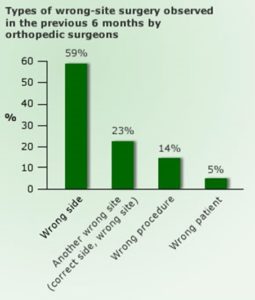Few medical errors are as vivid and terrifying as those that involve patients who have undergone surgery on the wrong body part, undergone the incorrect procedure, or had a procedure intended for another patient. These “wrong-site, wrong-procedure, wrong-patient errors” (WSPEs) are rightly termed never events—errors that should never occur and indicate serious underlying safety problems. The Agency for Healthcare Research and Quality recognizes that these events should not occur
Unfortunately, such mistakes although rare, are not unheard of.

A wrong-site surgery refers to an operation that occurs either on the wrong side, wrong patient or wrong side. These mistakes are more common in certain specialties, like spine and neurosurgery. Sometimes, the surgeon confuses patients with similar conditions but on different sides. Occasions have arisen where the x-ray, CT or MRI has been displayed backwards and caused an incision on the wrong side of the patient. Everyone in the operating room has a responsibility to confirm the patient and the procedure to be performed.
Who is liable for a wrong-site surgery?
Hospitals and medical professionals have put various safeguards in place to help reduce the risk of these errors. Some surgeons literally pre-mark the location or body part to be operated on prior to the patient going to the operating room. Once in the operating room, surgeons and their operating room staff typically call a “time-out” prior to the start of the procedure to take steps to ensure that the proper patient and part of the body for the anticipated surgery are confirmed. Repeating the patient’s name and identification, stating the procedure to be performed, and confirming the site before beginning the operation help to prevent wrong-site errors. Once the patient, procedure and incision location have been confirmed, the physician and staff move forward with the procedure.
Even with these safeguards in place, mistakes can happen if these procedures are not followed carefully. Since these mistakes are so egregious, they can lead to a medical malpractice claim. However, the question of liability can be more complicated than it first appears. Some examples of potentially liable parties when it comes to a wrong-site procedure include:
- Physician. The first defendant is often the surgeon who performed the wrong surgical procedure.
- Specialists. The physician who performed the procedure may have relied on advice from specialists like a radiologist. If that advice was flawed, this individual could also be responsible for the mistake.
- Staff. Additional medical staff help to facilitate the procedure. This can include those who input information, mark the site, and drape the patient. These preparatory measures are important and a failure to do so accurately can have catastrophic effects.
The Department of Health and Human Services has also noted that pressure to move patients in and or of operating rooms and keep operating schedules moving may cause surgeons and staff to shorten or rush the timeout. The timeout is the one thing that should never be rushed and requires the attention of every person in the operating room. Failing to devote complete focus during a timeout negates the benefit of this precautionary measure. As such, it is possible the hospital or medical facility itself could also bear some responsibility for this error.
It is important for victims of these cases to take the matter seriously. A wrong-site surgery can result in the need for additional medical procedures not just to address the initial problem that required surgical intervention in the first place, but also to fix any issues exacerbated by the mistaken surgical procedure. Medical expenses are only one part of the equation. Victims should also take the cost of additional expenses related to missed work and emotional stress into account when calculating the financial toll of this mistake.
